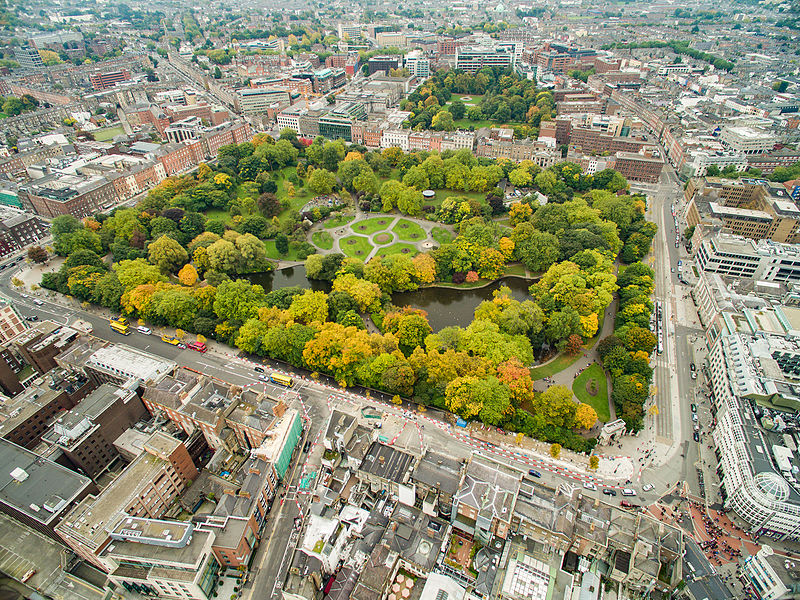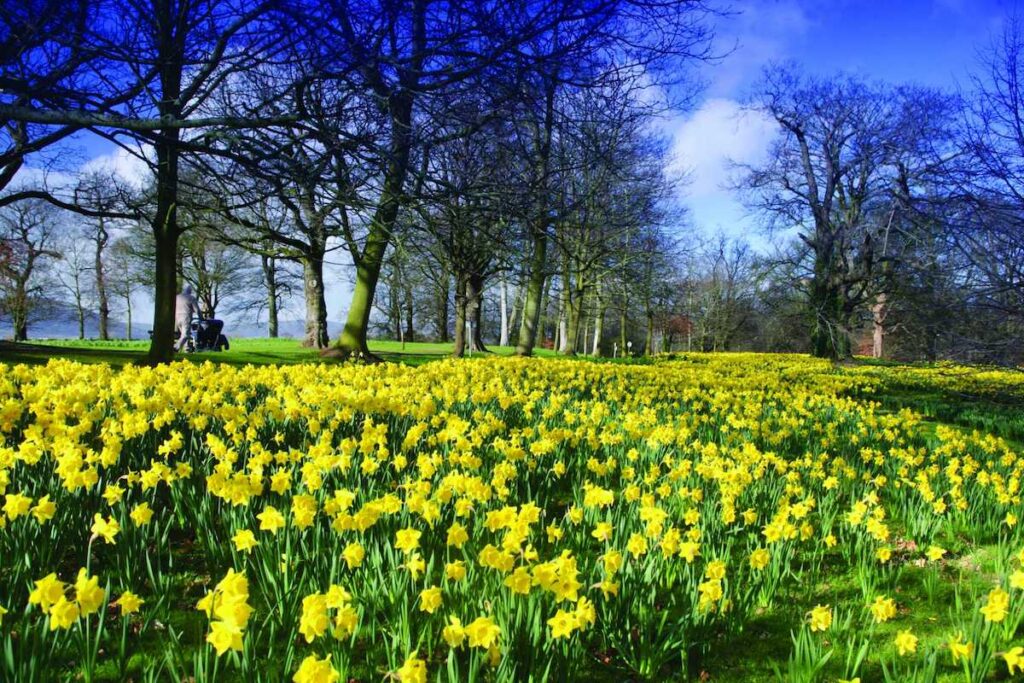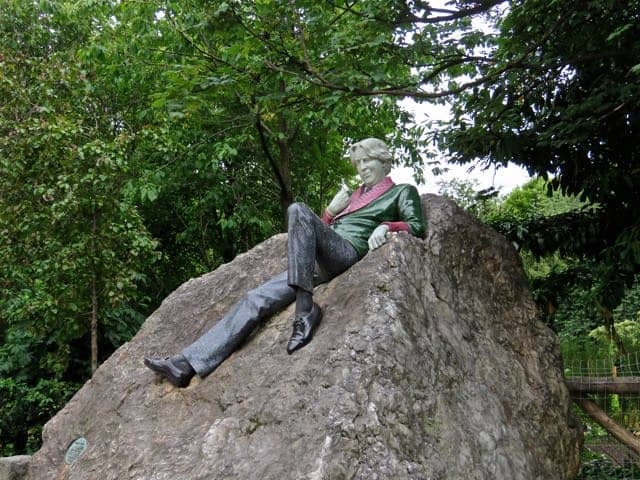Parks and Gardens to visit in Dublin
Dublin is not a concrete jungle; it has many green spaces where you can walk, take a break from the hustle and bustle, and enjoy Ireland’s natural beauty.
St Stephen’s Green

St Stephens Green is one of Dublin’s most evocative parks in the heart of town. It was initially built during the 17th-Centuries and is home to many historical memorials, such as statues of famous people, including James Joyce and Sir Arthur Guinness. Take a stroll through the beautiful gardens and admire the colourful flowers and trees. You can also enjoy watching ducks, swans and moorhen swimming around the ornamental lakes. In the northwest section of the Park, take a trip to the Famine Memorial, where thousands of people died from starvation during the Great Hunger.
Walk the pathways through St. Stephens Green.
Location: St. Stephen’s Green, Dublin 2
Opening times: Mon-Sat 7.30am; Sun and Holidays 9.30am; closing times according to daylight hours; open Christmas Day 10am-1pm.
Admission Fees: Free entry.
Parking: You will need to pay a fee to access private city parking or street parking.
Facilities: St Stephens gardens are located in the centre of Dublin, so there is a range of shops, cafés and restaurants nearby.
St Patrick’s Park
If you’re looking for an escape from the hustle and bustle of the city centre, head out to Phoenix Park. It’s a beautiful place to relax, take a break, and explore some of Dublin’s best green spaces. You can grab a cup of tea at the Tram Cafe near the park entrance and then take a leisurely stroll through the Park. You can also visit the Literary Parade, built in honour of Irish poets and writers who live here. See the Liberty Bell sculpture, which is a reminder of the neighbourhood in which the Park is situated.
It has a lot of history, but there’s some fun stuff too.
Phoenix Park Gardens

Phoenix Park is just two kilometres from Dublin’s central business district. Getting to the Park is accessible by public transportation, such as buses, trams, or cars. The Park covers an area of 1,750 acres, so visitors can easily spend several hours exploring the grounds. The Park also includes large grassy fields, wooded forests, and paved walkways. A highlight of the Park is the herd of wild Irish Feral Red and Fallow Deers who roam freely through the Park. Visitors should keep in mind that the Park closes at sunset.
The park sights also include:
Aras an Úachtarán – the Irish President‘s residence. Tours are available on Saturdays.
The original building was initially used by the chief bailiff of County Kerry; it later became the official residency of the US ambassador to Ireland.
The Papal Cross is an iconic symbol of the Catholic Church. It’s a large white cross that was built during the papacy of Pope John Paul II.
The Magazine Castle: This castle marks where Phoenix lodge was built by Sir Edward fisher in 1611. In 1734 the building was knocked down when the duke of Dorset ordered a powder magazine to be constructed. An additional wing was built in1801 for soldiers.
The Wellington Testimonium stands nearly 63 metres high and comprises four bronze plaquettes from cannonballs taken at Waterloo. It was built to tribute Arthur Wellesley, 1st Marquess of Wellington, born in Ireland.
Location: Dublin 8
How to get there using Dublin public transport:
By bus: No’s 37, 38, 39, 46A, 66, 67 from the city centre.
By Luas: Red line to Heuston Station, 10-minute walk to the park entrance on Chesterfield Ave.
Opening times: Open 24 hrs a day, 7 days a week, all year round. The side gates to the Park are open from 7am-11pm.
Admission Fees: Free entry.
Parking: Free parking.
Facilities: There is a café by the Zoo and formal gardens and a café at the visitors centre in the heart of the Park.
St Audoen’s Park and City Walls
The Park lies within the medieval walled town of Dublin. Here, you’ll discover St Audoen’s Arch – the final surviving entry point into the old city. The Park features an exciting collection of historical artefacts, including the remains of the ancient church of St Audoen’s. You’ll also be able to enjoy a drink at the nearby Brazen Head Pub, Ireland’s oldest pub.
Located in a suburb west of downtown, British architectural firm Sir Edwin Lutyens designed the Irish National War Memorial Gardens to remember Ireland’s 49,400 dead during WWI. It’s a beautiful park with a classical design. It is arranged from north to south with sunken flower gardens at each end and an internal stone wall. An excellent way to escape the hustle and bustle of the city.
Herbert Park
With its beautiful gardens, lakes, and bandshell, Ballsbridge’s 32-acre Herbert Gardens offers visitors a chance to escape city life’s hustle and bustle for a few hours. On Sundays, the garden transforms into one of Dublin’s best food markets. You can enjoy freshly baked bread, cheese, and produce from local farmers.
The second largest municipal green, St Anne’s Green, stretches over 240 acres in what was once an Irish estate belonging to the Guinness family in Dublin’s north side. This vast open land is home to wildlife like wild boars, hares, squirrels and foxes who live alongside several follies, including a Herculanean temple, a Pompeian water temple and a Roman viewing tower. There are ten, to be exact, around the River Naniken, which runs through the grounds. You’ll find a Hilarican Temple, a Pompeian Aqueduct and a Roman Tower overlooking duckponds. Suppose you’re here during weekends between 10am and 5 pm. In that case, you can enjoy these unusual sites while tasting homemade chocolates, artisan cheese, and handmade jams at the market stalls of the St Anne’s Green Market.
People’s Park
If you’re seeking an escape from the hustle and bustle of the big cities, take a trip out to the countryside. A short drive from Dublin, People’s Park is located just minutes from the shores of Dún Laogháirí (Dún Lough Harris). With its beautiful Victorian architecture, this Park offers visitors a chance to relax and unwind. Locals sell crafts and food at the weekly farmers’ market on Sundays. Take your kids along, too – they can play on the swings, slides and sandpit.
Marlay Park
If you’re looking for a challenging walk, then Marlay is definitely worth visiting. It has a 9-holed golf course, a tennis court, a dog playground, two kids’ playgrounds and a miniature train. And if you enjoy walking, this trail starts at Marlay and goes up into the mountains.
Bushy Park
It’s been there since 1700, but Bushy Park has been transformed into an international market village. You can enjoy local produce, artisanal foods, craft beers and wines, and live music every Saturday.
National Botanic Gardens National Botanic Gardens
In Glasnevin, just 3 km from Dublin’s city centre, grows a head-spinnin’ 15,000 species of flower. The restored 19th-century glasshouse, however, is even more impressive. Using computer controls to replicate environments around the world, the glasshouse contains different species, from wild Irish White Dryads to exotic palm trees. Join a Guiding Tour to learn more about the garden and the 300 rare flowers.
War Memorial Garden
This beautiful Park is located in the Dublin suburbs of Islandbridge and is one of my favourites. It’s surprisingly less busy than most parks in Dublin. It provides an ideal spot for escaping the hustle and bustle of the city.
It was built to commemorate the deaths of 49,400 Irish men who fought for their country during World Wars 1 and 2. Their names are inscribed in the beautiful stained glass windows in the buildings surrounding the memorial garden.
Sir Edwin Lutyens, an English landscape artist, created these beautiful Irish garden designs. He was best known for his architecture. He has been called “the greatest British designer since William Morris.” His most famous works include the Houses of Parliament in London and New Delhi.
The Park has beautiful views of Dublin Bay and offers a lovely riverside path. You can also enjoy picnics at one of the many cafes located here.
Location: South Circular Rd, Islandbridge. The entrance is from Con Colbert Rd and South Circular Rd (Phoenix Park end).
How to get there using Dublin public transport:
By bus: 51, 68 and 69 from Aston Quay.
By Luas: Red line to Heuston Station, 25-minute walk to the entrance.
By train: 25-minute walk from Heuston Station.
Opening Hours: Monday – Friday 8am, Saturday – Sunday 10am. Gardens close according to daylight hours.
Admission Fees: Free entry.
Parking: Free car park onsite.
Facilities: None.
Royal Hospital Kilmainham, Formal Gardens
This stunning formal Park, also known as the Master’s Gardens, is located on Dublin’s historic Royal Hospitals Kilmainham site. Built-in 1662, the Royal Hospitals were built to care for sick and wounded soldiers during times of war. Today, the buildings house the Irish Museum of Modern Arts (IMMA) and provide a peaceful setting for visitors and locals alike.
The formal gardens date back to 1732. A pretty cottage at the end of the gardens is named “The Lodge”. It is believed to be designed by Sir Edward Lovett Pearce, who created the House of Commons in London. The gardens feature lovely sculptures and statues.
Location: Military Road, Kilmainham, Dublin 8.
How to get there using Dublin public transport:
By Luas: Red line to Heuston Station, 8-minute walk to Museum entrance on Military Road.
By bus: Buses to Heuston Station (8 minutes walk via Military Rd): 145, 79 and 79a from Aston Quay. Buses to James St (8 minutes walk via steps to Bow Lane onto Irwin St and Military Rd): 13, 40, 123 from O’Connell St and Dame St.
By train: 8-minute walk from Heuston Station.
Opening Hours: Tuesday – Friday: 11.30am – 5.30pm; Saturday: 10am – 5.30pm; Sunday and Bank Holidays: 12pm – 5.30pm; Monday: Closed
Admission Fees: Free entry
Parking: Paid parking onsite.
Facilities: Bookshop and café.
National Botanic Gardens

Ireland’s National Botanic Gardens in Dubail is renowned for its wonderful botanical collection, housing over 15,000 plants from all over the globe. Its exquisite glasshouse was built by the Irishman Richard Turner, who also worked on the glasshouse at Kew Gardens and the Glasshouse at Belfast. These stunning glass houses were awarded the Europa Nostra prize for excellence in conservational architecture.
Visitors can enjoy the herbaceous border, rose garden, Alpine garden, pond area, rock garden and Arboretum. Conservation is an integral part of the Botanical Garden’s life. It is home to over 200 endangered plants around the globe, among six already extinct in nature.
Location: 3.5 km north of Dublin city centre, Botanic Road, Glasnevin.
How to get there using Dublin public transport:
By bus: It’s a bit too far to walk from the city centre, but the National Botanic Gardens can be reached by taking either Dublin city bus 4 or 83 from O’Connell Street.
Opening times: Winter opening times (October 27th to February) are Monday to Friday, 9am-4:30pm; Saturdays, Sundays and Public Holidays, 10am-4:30pm. Summer opening times (March to October) are Monday to Friday, 9am-5pm; Saturdays, Sundays and Public Holidays, 10am-6pm. The glasshouses close at 4.15pm in winter.
Admission Fees: Free entry.
Parking: Onsite parking is available for €2.
Facilities: Restaurant / Tearooms open daily in summer, 9am – 5pm and in winter, 10am – 4pm.
Iveagh Gardens

The Iveagh gardens are among the best and most well-kept of Dublin’s city parks and gardens. Designed by Ninian Niven in 1865 as an intermediate style between French and English landscapes, they demonstrate his artistic skill and show a unique collection of garden elements, including rustic grottoes, cascades, sunken formal panels, fountain centres pieces, wildernesses, woodlands, maze, rosaries, archery grounds, rockeries and rooteries.
The gardens began their restoration in 1995, and they’ve since been fully restored. Some features include the maze, box hedge, sundial, cascade, exotic trees, Victorian roses, and rosarium.
These parks often become inaccessible during the summer due to events held there.
Location: Access from Hatch Street. Disabled access to Clonmel Street and Hatch Street.
Opening Hours: Open all year Monday – Saturday 8am; Sunday and Bank Holidays: 10am; gardens closing times: December – January: 3.30pm; February and November: 4pm; March – October: 6pm.
Admission Fees: Free entry.
Parking: You will need to pay a fee to access private city parking or street parking.
Facilities: Iveagh Gardens are located in the centre of Dublin, so there is a range of shops, cafés and restaurants nearby.
Merrion Square Gardens

The Merrion Square garden has been designed using a “Jardin Anglais” approach. It features formal lawns, informal groups of trees and shrubs, curves and sunken paths, and perimeters planted with ornamental flowers and herbs.
There are a variety of interesting sculptures in these gardens, including one called “Oscar Wilde Reclining On A Rock”, which was designed by Sir Edward Maufe.
Surrounds the parks on three sides are grand Georgian houses. On the other side are Leinster house and two museums. Many of the homes have plaques documenting the rich and famous who used to live in them, such as Daniel O’Connell and William Butler Yeats. On Sunday, you’ll also see an art market showcasing talented artists who hang their artwork on the railings around the gardens.
Location: Merrion Square, Dublin 2.
Opening Hours: Open 7 days a week during daylight hours.
Admission Fees: Free entry.
Parking: You will need to pay a fee to access private city parking or street parking.
Facilities: Merrion Square is located in the centre of Dublin, so there is a range of shops, cafés and restaurants nearby.